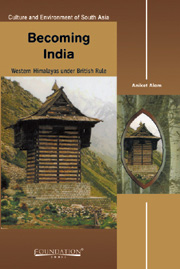Book contents
- Frontmatter
- Contents
- Preface
- Glossary
- Map
- Chapter 1 The Geography of the Western Himalayas
- Chapter 2 Political Economy of the Western Himalayas: Early Nineteenth Century
- Chapter 3 The Foundations of British Rule: Hill State, Hill Station, Land Settlement and Monetisation
- Chapter 4 Peasant Rebellions and Royal Reconciliation: British Rule inside the Hill States
- Chapter 5 Social Movements during British Rule
- Chapter 6 After Independence
- Conclusion
- Bibliography
- Index
Chapter 5 - Social Movements during British Rule
Published online by Cambridge University Press: 26 October 2011
- Frontmatter
- Contents
- Preface
- Glossary
- Map
- Chapter 1 The Geography of the Western Himalayas
- Chapter 2 Political Economy of the Western Himalayas: Early Nineteenth Century
- Chapter 3 The Foundations of British Rule: Hill State, Hill Station, Land Settlement and Monetisation
- Chapter 4 Peasant Rebellions and Royal Reconciliation: British Rule inside the Hill States
- Chapter 5 Social Movements during British Rule
- Chapter 6 After Independence
- Conclusion
- Bibliography
- Index
Summary
The social structure of the people living in the Western Himalayas was different from that found in the flat plains of the Punjab or the Ganges in some fundamental respects, as has been discussed at some length in Chapter 2. Almost all the members of the ruling families of the various Hill States traced their ancestry to immigrants who came to these mountains in the historical period. They, along with some of the priestly families associated with temples dedicated to divinities of the Hindu pantheon, followed the caste and other social codes of orthodox Hinduism. The main agricultural communities were collectively known as the Kanets and were members of the Khash tribe, divided into various clans and lineages. Each of these clans and lineages traced their origin to some mythical hero who was akin to a divine being. Apart from these Khash-Kanets, there was a considerable population of artisans, menial workers and landless agricultural workers who were ritually and economically dependent on the ruling families, temples and the peasant communities. Their origin was traced to pre- Khash tribes who were supposedly defeated and socially subordinated by the Khash during the Vedic period.
In contrast to the ruling families and orthodox priests, these two groups were not strict about either caste practices or other rituals of orthodox Hinduism, as defined in the Mitaksara codes. While the social differentiation and distance between the Khash-Kanets and the servile populations were well-marked, they did not yet amount to caste practices since many of the caste taboos were relatively weak and there is no reference to caste or ritual purity in their oral sources.
- Type
- Chapter
- Information
- Becoming IndiaWestern Himalayas under British Rule, pp. 208 - 253Publisher: Foundation BooksPrint publication year: 2007



